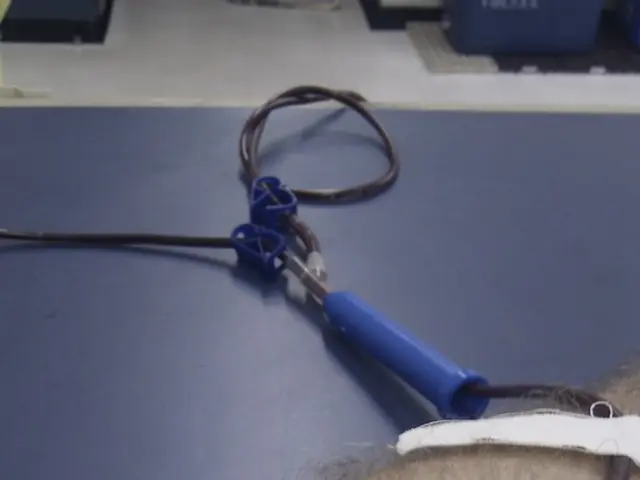Anticipated Healing Schedule for Hip Replacement: Understanding the Process
Recovery Following Hip Replacement Surgery: A Comprehensive Guide
A hip replacement surgery is a common orthopedic procedure aiming to alleviate pain and improve mobility in individuals suffering from hip joint conditions. The recovery timeline varies from person to person, but most patients can gradually return to light activities within three to six weeks post-surgery.
Preparing for Surgery
Preparing the body for a hip replacement surgery is essential to ensure a smoother recovery process and minimize the risk of complications. This preparation period typically spans several weeks before the surgery.
key steps in the preparation process include:
- Discussing the surgery with the doctor and healthcare team, researching what to expect during and after the procedure
- Seeking advice on exercises that strengthen the legs, core, and upper body before surgery
- Maintaining a moderate weight to reduce the risk of complications during surgery
- Limiting or quitting smoking
- Arranging for help with daily activities during the recovery period
- Preparing meals in advance
- Making home modifications like installing safety bars in the bathroom, obtaining a raised toilet seat, and acquiring a walker or crutches
First Few Days After Surgery
Most patients remain in the hospital for one to two days following a hip replacement surgery, although some may be discharged the same day. Pain relief medication, such as opioids, local anesthetic, nonsteroidal anti-inflammatory drugs (NSAIDs), or acetaminophen, is administered to manage pain during this initial phase.
The surgeon will typically stitch or staple the incision, which may require wound care at home. In the days following surgery, healthcare professionals will help the patient get up and move around as soon as possible. Assistance may be required to walk short distances. A physical therapist may instruct patients on exercises to strengthen the hip and provide guidance on activities to avoid.
Returning Home and Continued Recovery
After returning home, patients may require help with daily tasks for several weeks, or they may need to stay in a rehabilitation facility for an extended period. Pain and discomfort are common for a few weeks, and patients should continue taking any prescribed medication. Physical therapy or recommended exercises at home are crucial for speeding up recovery, improving flexibility, and regaining strength in the new joint.
Recovery Milestones
By ten to fourteen days after surgery, stitches should no longer be present, and pain and swelling may start to subside. Activity levels at this stage may vary, with some patients moving more easily without aid. For those who previously needed a cane or walker, they may still require assistance during this early recovery period.
Within three to six weeks, patients can generally resume light activities of daily living, feeling stronger, more stable, and comfortable putting more weight on their leg. Many patients may return to work after six weeks, but this timeline may vary. Sexual activity can be resumed after six to eight weeks. Patients should continue physical therapy for at least two months after surgery and consult their doctor before engaging in additional exercises like swimming or walking.
Long-Term Recovery
After three months, patients may be able to resume daily activities, and with their doctor's approval, low-impact sports. Recovery can vary, and patients should check in with their doctor for regular evaluations and to discuss the most beneficial physical therapy methods.
Tips for Improving Recovery
Patients can follow these tips to facilitate a better hip replacement recovery:
- Follow physical therapy exercises as instructed
- Engage in gentle exercises like daily walking
- Sit in a reclining position
- Apply a cold compress to reduce swelling
- Take any prescribed medication as directed
- Use walking aids like crutches if necessary
Older versus Younger Patients
Traditionally, hip replacements were not recommended for individuals under 20 years old due to unfavorable outcomes. However, cases where patients under 20 require a total hip replacement due to osteonecrosis of the femoral head can have positive outcomes, with the surgery relieving pain and restoring function.
Modern hip replacement implants are believed to lead to improved outcomes and survival rates in younger patients. Recovery for older adults can be more challenging due to potential comorbidities and compromised mobility.
Hip Resurfacing Recovery
In hip resurfacing surgery, the femoral head is trimmed and capped with a smooth metal cover rather than being removed. Most patients can go home one to four days after the surgery. Walking aids like a walker, cane, or crutches may be required for the first few days or weeks. Pain and discomfort are common for several weeks after the surgery, and a doctor may prescribe NSAIDs or opioids for severe pain. Physical therapy and exercises are essential for maintaining range of motion and restoring strength, with patients usually able to resume their regular activities around six weeks after surgery.
Hip Replacement Surgery Outlook
After a hip replacement surgery, patients typically experience improved mobility, reduced pain, and a better quality of life. However, there may be long-term effects like numbness, pain, or stiffness around the incision site. Hip replacements can impact various aspects of an individual's life, such as airport security metal detectors, high-impact sports, dental procedures, and sexual activity.
• follow physical therapy exercises as a physical therapist instructs• try other gentle exercises, such as daily walking• sit in a reclining position• use a cold compress to reduce swelling• take any prescription medications as a doctor instructs• use walking aids, such as crutches, if necessary
FAQs
Q: How long will it take to walk again after a hip replacement?A: Patients may be able to walk short distances with assistance on the same day as the surgery, with improvements in walking distance over the following weeks.
Q: How long does bed rest last after hip replacement surgery?A: Patients should start walking as soon as possible after hip replacement surgery and do not need to stay in bed.
Q: What age do they stop doing hip replacements?A: There is no age limit for hip replacements. Doctors consider various factors, including overall health and mobility, when deciding whether to perform the surgery.
Q: How long do hip implants or replacements last?A: A modern artificial hip replacement should last for at least 15 years, with 58% of cases lasting for over two decades.
• sitting still for long periods• crossing the legs at the knee• bending the hip more than 90 degrees• bending down to touch the feet or ankles• sitting in low chairs• intense exercise, which may involve jumping or sudden turns• moving or lifting heavy objects
Summary
Hip replacement and resurfacing surgeries have favorable outcomes and high success rates. Patients can begin recovery the same day as the surgery and will typically be able to walk a short distance with assistance soon afterward. Physical therapy in the hospital and at home can help rebuild strength and flexibility, speeding up recovery. Many patients can return to light activities within about six weeks and resume life as usual after about three months.
- The preparation process for a hip replacement surgery should include discussing the procedure with the doctor, seeking advice on pre-surgery exercises, maintaining a moderate weight, limiting or quitting smoking, arranging for help with daily activities during recovery, preparing meals in advance, and making home modifications.
- Navigating chronic medical conditions, such as COPD, obesity, colitis, Alzheimer's, chronic kidney disease, and various other chronic diseases, could impact the recovery process, necessitating additional considerations.
- The predictive role of science in health and wellness is increasingly important, as advances in medicine can help personalize recovery plans, accounting for factors like age, obesity, and chronic conditions.
- AQ (an aquatic therapy technique) can potentially aid in recovering from a hip replacement surgery due to the low-impact nature of water exercises, promoting flexibility and minimizing stress on the joint.
- CBD oil, due to its anti-inflammatory properties, may provide pain relief and contribute to a smoother recovery process following hip replacement surgery after consultation with a healthcare provider.
- Physical therapy, a crucial part of recovering from a hip replacement or a hip resurfacing surgery, may incorporate AQ and CBD as complementary methods to traditional exercises, provided by healthcare professionals.
- Monitoring long-term recovery involves regular evaluations by a doctor, staying informed about the benefits of various physical therapy methods, and maintaining a healthy lifestyle to minimize the risk of complications related to chronic diseases or other medical conditions.








